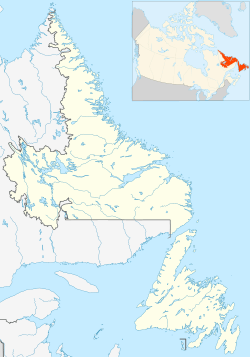Okak, Newfoundland and Labrador facts for kids
Quick facts for kids
Okak
|
|
|---|---|

Okak before 1919
|
|
Okak was once a community located on Okak Bay in northern Labrador. It was started in 1776 by Jens Haven, a missionary from the Moravian Church. Sadly, in 1918, a terrible sickness called the Spanish influenza came to Okak. It caused a lot of harm, killing 204 people out of 263.
Contents
The Moravian Mission in Okak
In 1771, King George III gave land to the Moravian Church. This was so they could build missions for the local Inuit people in northern Labrador. A mission is a place where missionaries live and work, often to share their beliefs and help the community.
In the 1700s, Jens Haven and his group built missions in several places. They built them at Nain (1771), Okak (1776), and Hopedale (1782). These missions were also used as trading posts, where people could buy and sell goods. Later, more Moravian settlements were built in other parts of Labrador.
The Flu Outbreak of 1918
In 1918, Moravian missionaries accidentally brought a very serious sickness to Okak. This sickness was called the Spanish influenza. It spread quickly and caused a lot of deaths in the community. Out of 263 people living in Okak, 204 died from the flu.
Soon after this sad event, the Moravians sold their trading post in Okak. The Hudson's Bay Company bought it. In 1956, the Canadian government asked the remaining people to move to other communities in Labrador. Because of this, Okak became an abandoned settlement. Today, all that is left of Okak are a graveyard and the old mission buildings in ruins.
Okak National Historic Site
Okak was named a National Historic Site of Canada in 1978. This is because of the old Moravian mission and many archaeological sites in the area. An archaeological site is a place where people find old things from the past. There are over 60 such sites around Okak Bay.
These sites show that people have lived in this area for a very long time. They date back to about 5550 BCE. This means they are over 7,500 years old! The sites tell us about different groups of people who lived there. These include the Maritime Archaic people and the Labrador Inuit.
Ancient Cultures of Okak
The archaeological finds at Okak show a long history of human life. They include evidence of several ancient cultures:
- Maritime Archaic (around 5550 BCE to 1550 BCE): These were early people who lived by the sea.
- Paleo-Eskimo (around 1850 BCE to 250 BCE): This group includes the Pre-Dorset culture.
- Intermediate Indian (around 1550 BCE to 250 BCE)
- Dorset (around 550 BCE to 1450 CE): Also known as the Dorset culture.
- Labrador Inuit (around 1200 CE to today)
The things found at these sites are mostly stone tools and flakes. These items help experts understand how tools changed over time. They also show how different groups made their tools and where they got their materials. The oldest things found are from the Maritime Archaic period on Cut Throat Island.
The Mission's Beginnings and End
In 1776, Moravian Missionaries built their mission on Okak Island. This island is just off Okak Harbour. It was the second successful mission they built on the Labrador Coast. The first one was in Nain, about 400 kilometers (250 miles) to the south, built in 1771.
The Okak Mission buildings were built first in Nain. Then, they were taken apart and moved north to Okak. They also brought a provisions house (for storing food) and a bake house. Inuit families gradually moved closer to the mission and built their own houses there.
However, hunting patterns changed over time. And then, the Spanish Influenza epidemic hit in 1918-1919. These events led to the mission being abandoned in 1919. Today, you can still see the foundations of the buildings, walkways, and a wharf from the mission era.


